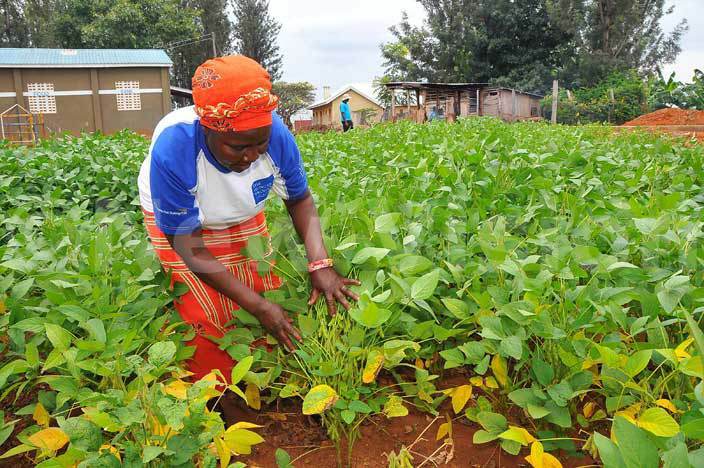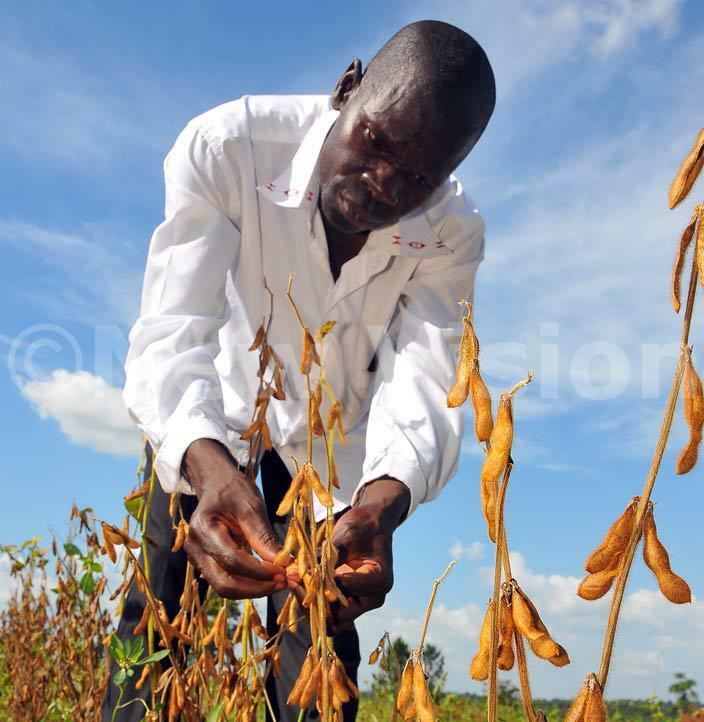2016: A year to re-think nutrition and value chains for pulses
The focus on pulses was for the first time listed on global agenda to increase awareness of the profitable and nutritive value they offer
Since the declaration by the United Nations General Assembly to have 2016 as the International Year of pulses, countries around the world have taken deliberate steps to improve the related value chains.
This comes as part of the United Nations themes which have included, among others, 2011 year of forests, 2014 year of family farming and 2015 international year of soils.
The focus on pulses was for the first time listed on global agenda to increase awareness of the profitable and nutritive value they offer.
However, according to experts in Uganda, the value chains for these protein-giving crops still face outstanding challenges and limited sensitization despite their vital nutrient content.
 A woman checks on her bean garden
A woman checks on her bean garden
What are pulses?
Going by the United Nations definition, legumes are plants whose fruits are enclosed in a pod.
Pulses are part of the legume family except that they are usually harvested for purposes of using the dry seed, majorly beans and lentils.
Among them are plants like dry beans, broad beans, chick peas, dry cow peas, Lentils, dry peas, pigeon peas, soybeans vetches and peanuts (groundnut).
Market standings
According to the 2010 FAO rankings, the top producers for selected pulses around the world include Brazil for dry beans, China for Broad and horse beans, India for Pigeon peas and Chick peas, Nigeria for dry Cowpeas, Canada for dry peas and Lentils, China for peanuts (groundnut), the USA for Soybeans and Ethiopia for Vetches.
Nutritive value
According to Felix Kageza, the General Manager at the Uganda Groundnuts Processing Initiative International Technologies Transfer Limited (UGPI-ITT) in Soroti district, pulses are high in protein and fibre.
"With these plants in your diet, you have good protein that is much more affordable. Pulses are not expensive," he says.

From research, proteins are known to prevent both heart and liver disorders if taken in the right amounts.
Fast maturing, quicker profits
Patience Rwamigisa, the Public Relations Officer of the Ministry Of Agriculture Animal Industry and Fisheries, says pulses like beans require less time to mature as they spend only about three months in the ground.
"They should take at least three months. That is about a quarter of the year," Rwamigisa says.
Prospects for profit
Kageza from Soroti district says that the value chains for pulses are indeed profitable.
"Groundnuts, for instance, have 47% oil content. If you are looking beyond production to value addition, this oil can be of use," Kageza says.
After seven years' experience with peanut (groundnuts) Kageza says one can make large amounts of marketable cooking oil, paste, cosmetics, biscuits, chocolate and animal feeds as well as lotion.
"You can also roast the seeds at industrial level and penetrate the export markets," he says.
Kageza adds that one acre under production of groundnuts should give 10 to 15 bags of between 42 and 50 kilos that can fetch 70,000 to 120,000 every two months.
"If we learn from countries like South Africa we can even have up to 30 bags per acre," Kageza says.
Practices for sizeable output
Similar to other crop enterprises, pulses can only give the expected cash returns if grown under the right conditions and maintained with the right agronomic practices on the farm.
Beatrice Byarugaba, the acting director of the agriculture ministry's Directorate for Agricultural Extension Services, advises farmers to look out for the fast-maturing varieties of pulses first.

"Before you plant, you should know how long the crops are supposed to take," Byarugaba says.
Furthermore, Byarugaba says that beans, peas and groundnuts can hardly thrive with weeds.
"The seedbeds and the gardens have to be weed-free all the time. Otherwise they can outcompete your crops for nutrients and sunlight," the director cautions.
She also advises farmers to weed the gardens before the crops start flowering.
"For beans, for example, you have to weed before the canopies close. If you weed after flowering you are most likely to knock the flowers to the ground and hinder growth of the beans," she says.
To improve the fertility of the soil, Byarugaba says these crops need a bit of manure that can be added to the soil at planting.
She also recommends early ploughing to give the best conditions for the soil.
"A farmer has to plough early to allow the soil to rest and stabilise before the seeds can be sown," Byarugaba says.
Disease prevention
Byarugaba says many farmers end up with diseased gardens because of negligence and purchasing seeds from multiple sources.
"You can sell off good quality beans or peas and then go out to buy poor quality seeds for planting," she says.
She, however, says, you can avoid this by maintaining the seeds from your garden and planting from the same, at least three times.
"Aside from that, you have to sort the seeds that you buy to make sure that they are not having weevils," she adds.
Land selection
The extension director says beans and peas require only well-drained soils and not soggy ones.
"With a lot of water in the soil, beans will develop root-rot disease," she points out.
Byarugaba says that if the land is relatively wet, one should then consider digging mounds and planting the beans in the mounds as is the case for potatoes.
Value chain inhibitions
UGPI's Kageza singles out pulses like groundnuts to have outstanding challenges, mainly the dealings by the middlemen.
"Since the farmers barely have co-operative societies or regional processing centres, they are cheated by middlemen. They buy the bags at between sh40,000 and sh50,000 from the farmers and sell them at as much as sh120,000," Kageza says.
Though they exist in more than 13,000 species worldwide, only selected pulses can be marketed for good returns in Ugandan markets today, including beans, peas and peanuts (groundnuts) and much more remains undone for these value chains as compared to other crops in Uganda.